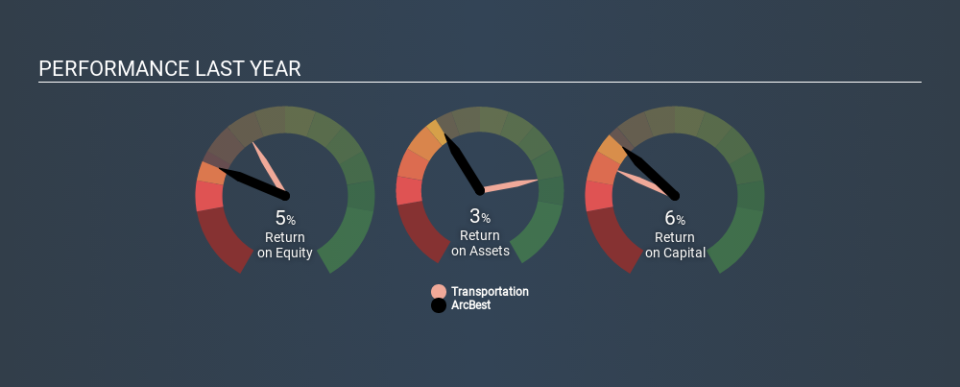Here’s why ArcBest Corporation’s (NASDAQ:ARCB) Returns On Capital Matters So Much

Today we'll evaluate ArcBest Corporation (NASDAQ:ARCB) to determine whether it could have potential as an investment idea. To be precise, we'll consider its Return On Capital Employed (ROCE), as that will inform our view of the quality of the business.
Firstly, we'll go over how we calculate ROCE. Next, we'll compare it to others in its industry. Last but not least, we'll look at what impact its current liabilities have on its ROCE.
Return On Capital Employed (ROCE): What is it?
ROCE measures the amount of pre-tax profits a company can generate from the capital employed in its business. Generally speaking a higher ROCE is better. Overall, it is a valuable metric that has its flaws. Renowned investment researcher Michael Mauboussin has suggested that a high ROCE can indicate that 'one dollar invested in the company generates value of more than one dollar'.
How Do You Calculate Return On Capital Employed?
Analysts use this formula to calculate return on capital employed:
Return on Capital Employed = Earnings Before Interest and Tax (EBIT) ÷ (Total Assets - Current Liabilities)
Or for ArcBest:
0.064 = US$77m ÷ (US$1.7b - US$444m) (Based on the trailing twelve months to December 2019.)
So, ArcBest has an ROCE of 6.4%.
See our latest analysis for ArcBest
Is ArcBest's ROCE Good?
ROCE can be useful when making comparisons, such as between similar companies. In this analysis, ArcBest's ROCE appears meaningfully below the 11% average reported by the Transportation industry. This performance is not ideal, as it suggests the company may not be deploying its capital as effectively as some competitors. Separate from how ArcBest stacks up against its industry, its ROCE in absolute terms is mediocre; relative to the returns on government bonds. Investors may wish to consider higher-performing investments.
We can see that, ArcBest currently has an ROCE of 6.4% compared to its ROCE 3 years ago, which was 4.0%. This makes us think about whether the company has been reinvesting shrewdly. You can see in the image below how ArcBest's ROCE compares to its industry. Click to see more on past growth.
It is important to remember that ROCE shows past performance, and is not necessarily predictive. ROCE can be deceptive for cyclical businesses, as returns can look incredible in boom times, and terribly low in downturns. This is because ROCE only looks at one year, instead of considering returns across a whole cycle. Future performance is what matters, and you can see analyst predictions in our free report on analyst forecasts for the company.
ArcBest's Current Liabilities And Their Impact On Its ROCE
Short term (or current) liabilities, are things like supplier invoices, overdrafts, or tax bills that need to be paid within 12 months. Due to the way the ROCE equation works, having large bills due in the near term can make it look as though a company has less capital employed, and thus a higher ROCE than usual. To counteract this, we check if a company has high current liabilities, relative to its total assets.
ArcBest has total assets of US$1.7b and current liabilities of US$444m. As a result, its current liabilities are equal to approximately 27% of its total assets. It is good to see a restrained amount of current liabilities, as this limits the effect on ROCE.
What We Can Learn From ArcBest's ROCE
That said, ArcBest's ROCE is mediocre, there may be more attractive investments around. Of course, you might also be able to find a better stock than ArcBest. So you may wish to see this free collection of other companies that have grown earnings strongly.
I will like ArcBest better if I see some big insider buys. While we wait, check out this free list of growing companies with considerable, recent, insider buying.
If you spot an error that warrants correction, please contact the editor at editorial-team@simplywallst.com. This article by Simply Wall St is general in nature. It does not constitute a recommendation to buy or sell any stock, and does not take account of your objectives, or your financial situation. Simply Wall St has no position in the stocks mentioned.
We aim to bring you long-term focused research analysis driven by fundamental data. Note that our analysis may not factor in the latest price-sensitive company announcements or qualitative material. Thank you for reading.


